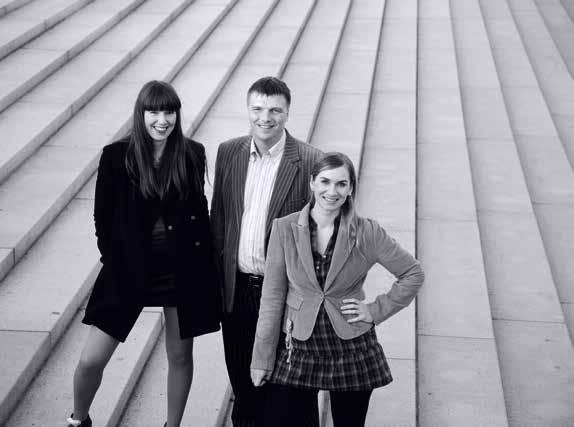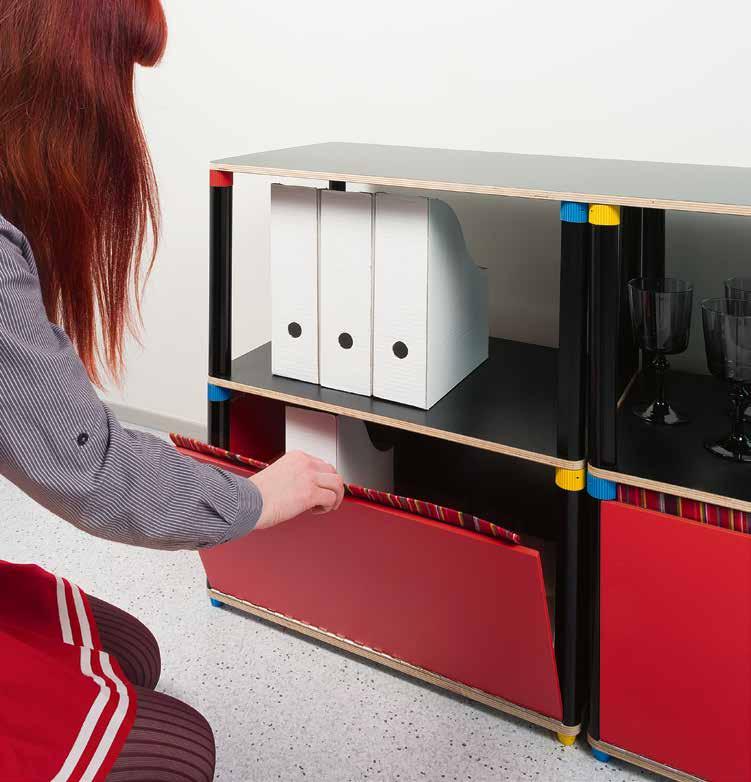
7 minute read
MOOdULMööBLISÜSTEEM L.E.S.S
from RUUMIPILT 2012
Kard Männil ja Loreida Hein on alustanud peale Eesti Kunstiakadeemia sisearhitektuuri kateedri lõpetamist oma sisearhitektuuri-stuudiotega, teinud koostööd teiste disaineritega paljude projektide raames. Nad on loonud mitmeid era- ja avalikke interjööre koos erimööbliga, teostanud käsitsi suuremõõdulist seinagraafikat. Mõlemad on olnud ka sisustussaate juhid. Timo Subbi on õppinud ehitusinseneriks ning arhitektiks, tegelnud ka ettevõtluse ja loometööga disaini valdkonnas.
Kard Männil and Loreida Hein have started up their own interior architecture studios after graduating from the Estonian Academy of Arts Department of Interior Architecture and Furniture Design. They have worked together with other designers within the framework of numerous projects. They have created several private and public interiors with custom designed furniture and created large-scale wall graphics by hand. They have both also been the hosts of a programme on furnishings. Timo Subbi has studied engineering and architecture. He has also worked in enterprise and creative work in the field of design.
Advertisement
www.less-furniture.com
moodulmööBli - SÜSteem l.e.S.S.
Modular furniturE systEM l.E.s.s.
autorid/authors:
fotod/photos: Loreida Hein, Kard Männil,
Timo Subbi (L.e.s.s.)
Kaido Haagen

tahtsime koju kummutit, mis ei oleks päris valmis, lõpuni komponeeritud, ära kujundatud. Mitte valmis seisukohavõttu, vaid natuke juhuslikku teelolemist, mis samas näeks hea välja. loreida/Kardi/timo mööbel on just selline, liigsest ambitsioonikusest hoiduv, ent iseteadlik ja elegantne.
Karli Luik, arhitekt

Et paigal püsida, tuleb kõigest väest joosta. Elu kiire muutumine ja sellega kohanemine on päevakohane teema ka mööblimaailmas. Kas kõike on juba põhimõtteliselt tehtud – või mida vajab 21. sajandi nomaad?
Mis on selle mööbliseeria tekkelugu, kuidas see kõik alguse sai? Kard Männil (KM): Elu muutub järjest mobiilsemaks ja inimeste elud üha dünaamilisemaks, aga interjöörid on oma olemuselt endiselt staatilised. Meie mööbli idee sai alguse meie endi vajadusest liikuva mööbli järele, mis oleks võimeline omanikuga kaasa muutuma, nn smart office, mida saaks kiirelt ja mugavalt teise kohta kolida. Loreida Hein (LH): Unistus asjast, mis on kohandatav, kui tahad kuhugi mujale minna, midagi teistsugust, et siis ei pea uut muretsema, vaid saad sama asja ümber mängida. KM: 30aastane inimene Pariisis on vähemalt 10 korda kolinud. Kõik need üürikorterid on sellised, kus on vaid kraanikauss ja mitte midagi muud, kööki ka. Tee, mis tahad, kui ära lähed, peab samamoodi jääma. Mina olen elus palju pidanud kolima ja see on keeruline, lõputu kastide tellimine ja pakkimine. Samuti ka siis, kui alustad uut firmat, alguses on ühed vajadused, homme juba järgmised, elu võiks kuidagi lihtsam olla.
Mis on algselt inspireerinud, kui mingeid piiranguid ees ei olnud? KM: Et süsteemi algidee hakkas idanema mu arhitektist venna Timo peas, on ka lõpplahenduses tunda arhitektuurset lähenemist. Mööbli konstruktsioon on jäik, tugev, pulkadeks lahtivõetav, ja kui midagi läheb katki, saab ühe osa ümber vahetada. Kasutusaeg ongi kõige suurem ökoloogiline aspekt. LH: Praktiline vajadus ongi meid inspireerinud... Elanikkond vananeb ja keegi ei taha tunnistada, et on asju, mida ta enam üksinda teha ei jaksa. aga selle mööbli nihutamisega saab ise hakkama küll.
Milline on selle mööbli suhe ruumiga – kas see eeldab mingit kindlat ruumi? KM: oleme püüdnud välimust neutraalse hoida, et see oleks pigem nagu ehitusklots, mida saab muuta eri värvi detaile valides. Nii et see on suhteliselt anonüümne, et sobituks ükskõik millise ruumiga. See on nagu lego-süsteem.
Kuidas edasi, kas plaanite oma mööbliga ka messile jõuda? LH: Messile ei saa enne minna, kui patenditaotlused sisse antud. Kopeerimise eest ei pruugi patent täit kaitset anda ning liiga vara välja tulles kaotaksime oma edumaa selles võidujooksus. aga mine tea, äkki järgmisel aastal. KM: oleme käinud vaatamas, kuhu maailm suundub. Milano messil oli üldine suund home office, inimesed töötavad reaalselt kolm-neli päeva nädalas kodus. arendame tootmist ise, see on lõputu protsess, et leida õiged materjalid. Hetkel juurutame küljedetailideks Koskineni tehases toonitud ja kuumtöödeldud vineeri, mis ei vaja täiendavat kaitsekihti laki näol. Nüüd oleme jõudnud brändingu etappi. alustasime out of box nime all, nüüd, kus mööbel ekspordiks valmis, on meil ka uus nimi l.e.s.s. – furniture redefined. Tänu ajujahi konkursile, kuhu me läksime ideega ja lõpetasime prototüübiga, on meil üsna arvestatavad mentorid. Edasi sattusime huvitavatesse koolitusprogrammidesse, nagu näiteks Start Smart. Mööblisüsteemi väljaarendamiseks oleme toetust ja abi saanud nii EaSi innoosakute näol kui ka ESList ja sisearhitektuuri kateedrist. Täname!
One must run with all one’s might just to stand still. Rapid changes in lifestyle and adaptation to those changes are topics of current interest in the world of furniture as well. Has basically everything already been done – or what does a 21st century nomad need?
How did this furniture line come about and where did it all start? Kard Männil (KM): Life is becoming more and more mobile and people’s lives are becoming ever more dynamic, but interiors remain essentially static. Our furniture idea originated from our own needs for moveable furniture that could change along with its owner, a socalled smart office that could quickly and conveniently be moved to a different location. Loreida Hein (LH): The dream of something adjustable when you want to go somewhere else, something different, so you don’t have to get a new one. Instead, you can revamp the same thing. KM: A 30-year-old in Paris has moved at least 10 times. All those rental flats are the kind where there is only a washbasin and nothing else, not even a kitchen. Whatever you do, when you move out, it has to be left the same way. I’ve had to move many times in my life and it’s complicated, an endless ordering of boxes and packing. It’s the same thing when you start up a new company. First there are certain needs, and tomorrow there are different needs. Life could somehow be simpler.
What initially inspired you if you had no restrictions? KM: Since the system’s original idea started germinating in the head of my architect brother Timo, an architectural approach can also be sensed in the final result. The structure of the furniture is rigid, strong and can be disassembled, and if something breaks, one part can be replaced. The duration of usage is the most important ecological aspect. LH: Practical need is what inspired us…The population is aging and nobody wants to admit that there are things that he no longer can manage to do alone. But people can move this furniture around by themselves.
What is the relation between this furniture and the room it is in – does it require any particular kind of room? KM: We have tried to keep its appearance neutral so that it would be more like a building block that can be changed by choosing details of different colours. So it is relatively anonymous so that it could fit in with any kind of room. It’s like a Lego system.
What is next, are you planning to make it to the furniture fair with your furniture? LH: We can’t take our product to the fair before the patent applications have been submitted. A patent will not necessarily completely protect you against copying and if we come out with our idea too soon, we would lose our head start in this race. But you never know, maybe next year. KM: We’ve gone to have a look at where the world is headed. The general trend at the Milan fair was the home office. People actually work at home three to four days a week. We develop production ourselves. It’s an endless process to find the right materials. We’re currently introducing plywood stained and heat treated at the Koskinen factory as side details that do not require an additional protective coating in the form of lacquer. Now we’ve reached the branding stage. We started out under the name Out of Box. Now that the furniture is ready for export, we also have a new name, l.e.s.s. – furniture redefined. Thanks to the Ajujaht (Chase) competition, where we went with an idea and finished with a prototype, we have mentors to be reckoned with. Since then we ended up in interesting training programmes like, for instance, Start Smart. We have received support and assistance for developing our furniture system from both Enterprise Estonia (EAS) innovation stakes as well as from the Estonian Association of Interior Architects (ESL) and the Estonian Academy of Arts Department of Interior Architecture and Furniture Design. Thank you!


We wanted a dresser for our home that isn’t quite finished, completely composed and designed. Not a ready-made attitude but rather a somewhat random condition of being on the way, which would look good at the same time. Loreida’s/Kard’s/ Timo’s furniture is exactly that kind, avoiding excessive ambitiousness, yet self-assertive and elegant.
Karli Luik, architect










